Volume 28.2
May–August 2025
Full table of contents
ISSN: 1094-8074, web version;
1935-3952, print version
Recent Research Articles
See all articles in 28.2 May-August 2025
See all articles in 28.1 January-April 2025
See all articles in 27.3 September-December 2024
See all articles in 27.2 May-August 2024
Interested in submitting a paper to Palaeontologia Electronica?
Click here to register and submit.
Article Search
APPENDIX 1.
List of the sauropod material from the Lusitanian Basin Upper Jurassic.
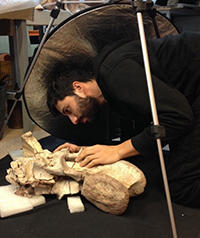 Pedro Mocho. The Dinosaur Institute, Natural History Museum of Los Angeles County, 900 Exposition Blvd., 90007 CA, Los Angeles, USA; Grupo de Biología Evolutiva, Facultad de Ciencias, UNED, c/ Senda del Rey, 9, 28040 Madrid, Spain; Laboratório de Paleontologia e Paleoecologia, Sociedade de História Natural, Polígono Industrial do Alto do Ameal, Pav.H02 e H06, 2565-641, Torres Vedras, Portugal. pmocho@nhm.org
Pedro Mocho. The Dinosaur Institute, Natural History Museum of Los Angeles County, 900 Exposition Blvd., 90007 CA, Los Angeles, USA; Grupo de Biología Evolutiva, Facultad de Ciencias, UNED, c/ Senda del Rey, 9, 28040 Madrid, Spain; Laboratório de Paleontologia e Paleoecologia, Sociedade de História Natural, Polígono Industrial do Alto do Ameal, Pav.H02 e H06, 2565-641, Torres Vedras, Portugal. pmocho@nhm.org
Dr. Pedro Mocho is a geologist who did his undergraduate studies at the Universidade de Lisboa (Portugal) and received his M.Sc. in Biodiversity and his Ph.D. in Biology from the Universidad Autónoma de Madrid in 2016, under the supervision of Dr. Francisco Ortega and Dr. Rafael Royo-Torres. He is now a Postdoctoral Research Associate in the Dinosaur Institute of the Natural History Museum of Los Angeles County. His main research is focused on the evolutionary history of sauropod dinosaurs, in particular the phylogenetic context of the Upper Jurassic sauropods of the Iberian Peninsula (Portugal and Spain) and North America (USA). In the Dinosaur Institute, he is working on the systematics and paleobiology of the sauropods from the "Gnatalie" quarry (Upper Jurassic, Utah) and from the Bisti/De-Na-Zin Wilderness (Upper Cretaceous, New Mexico). He is also studying Middle Jurassic sauropods from Africa and the evolution of Titanosauriforms during the Early and Upper Cretaceous, including new research on several forms from Spain, North America, and Africa. He is collaborating on different paleontological research and outreach projects in Spain, Portugal, and the United States. His research is especially focused on the evolutionary history of non-neosauropod eusauropods, the Upper Jurassic diversification of neosauropods and in the evolutionary history of european titanosars. His research has taken him on several national and international expeditions in Western Portugal, Utah, New Mexico, and Spain. He is also member of the Grupo de Biología Evolutiva, UNED (Spain) and Sociedade de História Natural (Torres Vedras, Portugal).

 Rafael Royo-Torres. Fundación Conjunto Paleontológico de Teruel-Dinópolis/Museo Aragonés de Paleontología, av. Sagunto s/n. E-44002 Teruel, Spain. royo@dinopolis.com
Rafael Royo-Torres. Fundación Conjunto Paleontológico de Teruel-Dinópolis/Museo Aragonés de Paleontología, av. Sagunto s/n. E-44002 Teruel, Spain. royo@dinopolis.com
Rafael Royo Torres received his PHD in 2006 at Facultad de Ciencias of the Zaragoza University (Departamento Ciencias de la Tierra) Spain. He has been working like paleontologist of the Fundación Conjunto Paleontológico de Teruel-Dinópolis since 1998 for the Dinopolis project in Spain. His main research interests are the phylogeny and evolution of sauropod dinosaurs, in particular of the Late Jurassic and Early Cretaceous faunas from the Spain, France and Portugal, respectively, where he also participated in various excavation campaigns. He has produced more than 50 publications in scientific journals, being first author in journals such as Science, where Turiasaurus riodevensis was defined in 2006. He is currently involved in I+D+I projects of the Spain Goverment and co-manages several dissertations of dinosaurs from Spain.

 Fernando Escaso. Grupo de Biología Evolutiva, Facultad de Ciencias, UNED, c/ Senda del Rey, 9, 28040 Madrid, Spain; Laboratório de Paleontologia e Paleoecologia, Sociedade de História Natural, Polígono Industrial do Alto do Ameal, Pav.H02 e H06, 2565-641, Torres Vedras, Portugal. fescaso@ccia.uned.es
Fernando Escaso. Grupo de Biología Evolutiva, Facultad de Ciencias, UNED, c/ Senda del Rey, 9, 28040 Madrid, Spain; Laboratório de Paleontologia e Paleoecologia, Sociedade de História Natural, Polígono Industrial do Alto do Ameal, Pav.H02 e H06, 2565-641, Torres Vedras, Portugal. fescaso@ccia.uned.es
Fernando Escaso is an Assistant Professor at the Science Faculty of the Universidad de Educación a Distancia (UNED), Spain. His research is focused in the evolutionary history of the ornithischian dinosaurs from the Late Jurassic of the Iberian Peninsula and their relationships with the synchronous faunas of Laurasia. Also, other research interest are the study of the ornithopod dinosaur faunas from the Cretaceous of southwestern Europe.

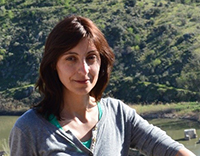 Elisabete Malafaia. Instituto Dom Luiz, Universidade de Lisboa. Edifício C6, Campo Grande, 1749-016 Lisboa, Portugal; Museu Nacional de História Natural e da Ciência, Rua da Escola Politécnica 56/58, 1250-102 Lisboa, Portugal; Laboratório de Paleontologia e Paleoecologia, Sociedade de História Natural, Polígono Industrial do Alto do Ameal, Pav.H02 e H06, 2565-641, Torres Vedras, Portugal. emalafaia@gmail.com
Elisabete Malafaia. Instituto Dom Luiz, Universidade de Lisboa. Edifício C6, Campo Grande, 1749-016 Lisboa, Portugal; Museu Nacional de História Natural e da Ciência, Rua da Escola Politécnica 56/58, 1250-102 Lisboa, Portugal; Laboratório de Paleontologia e Paleoecologia, Sociedade de História Natural, Polígono Industrial do Alto do Ameal, Pav.H02 e H06, 2565-641, Torres Vedras, Portugal. emalafaia@gmail.com
Elisabete Malafaia started the PhD at Faculdade de Ciências da Universidade de Lisboa in 2012. Your main research interests are the phylogeny and evolution of theropod dinosaurs. She is interested in particular in the paleobiogeographic evolution of the Late Jurassic faunas from Portugal and its relationships with other correlative faunas of the peri-Atlantic context.

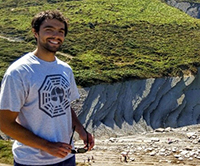 Carlos de Miguel Chaves. Grupo de Biología Evolutiva, Facultad de Ciencias, UNED, c/ Senda del Rey, 9, 28040 Madrid, Spain. carlos.miguelchaves@gmail.com
Carlos de Miguel Chaves. Grupo de Biología Evolutiva, Facultad de Ciencias, UNED, c/ Senda del Rey, 9, 28040 Madrid, Spain. carlos.miguelchaves@gmail.com
Carlos de Miguel Chaves graduated in the Universidad Autónoma de Madrid with a bachellor's degree in Biology in 2012, and he studied a master's degree in Evolutionary Biology at the Universidad Complutense de Madrid. In 2014 he joined the Group of Evolutionary Biology at the National University of Distance Education (UNED), where he curses his PhD studies. His work focus on the fossil record of Triassic sauropterygian reptiles from the Iberian Peninsula.

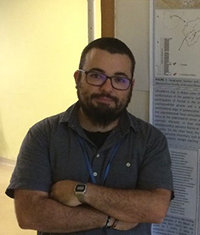 Iván Narváez. Grupo de Biología Evolutiva, Facultad de Ciencias, UNED, c/ Senda del Rey, 9, 28040 Madrid, Spain. i.narvaez.padilla@gmail.com
Iván Narváez. Grupo de Biología Evolutiva, Facultad de Ciencias, UNED, c/ Senda del Rey, 9, 28040 Madrid, Spain. i.narvaez.padilla@gmail.com
Iván Narváez received his MSc on paleontology in the Universidad Complutense de Madrid in 2009 and his PhD in Biology in Universidad Autónoma de Madrid in 2015, under the supervision of Francisco Ortega and Christopher A. Brochu. His research is focused on the study of the evolutionary history of the basal Eusuchian crocodiles from the Late Cretaceous of Europe and the phylogenetic relationship of these groups with synchronous faunas in Laurasia. In addition, he is interested on the study of dinosaur diversity from Iberian Peninsula.

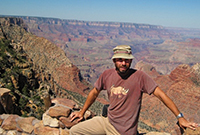 Adán Pérez-García. Grupo de Biología Evolutiva, Facultad de Ciencias, UNED, c/ Senda del Rey, 9, 28040 Madrid, Spain; Laboratório de Paleontologia e Paleoecologia, Sociedade de História Natural, Polígono Industrial do Alto do Ameal, Pav.H02 e H06, 2565-641, Torres Vedras, Portugal. paleontologo@gmail.com
Adán Pérez-García. Grupo de Biología Evolutiva, Facultad de Ciencias, UNED, c/ Senda del Rey, 9, 28040 Madrid, Spain; Laboratório de Paleontologia e Paleoecologia, Sociedade de História Natural, Polígono Industrial do Alto do Ameal, Pav.H02 e H06, 2565-641, Torres Vedras, Portugal. paleontologo@gmail.com
Adán Pérez-García is a paleontologist working on several clades of reptiles, mainly on Testudinata. He obtained his PhD on the fossil turtles from the Iberian Peninsula in 2012, at the Universidad Complutense de Madrid. He is now a researcher at the Universidad Nacional de Educación a Distancia (Madrid). His main work focuses on the study of the systematics, paleobiogeography and diversity of Mesozoic and Cenozoic faunas of turtles from the Jurassic to the Holocene, including both European and African clades. He described several new taxa corresponding to pan-pleurodiran and pan-cryptodiran forms.

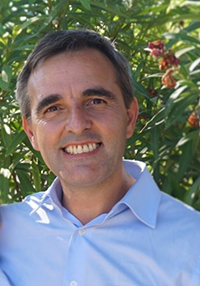 Nuno Pimentel. Instituto Dom Luiz, Universidade de Lisboa, edifício C6, Campo Grande, 1749-016 Lisboa, Portugal. pimentel@fc.ul.pt
Nuno Pimentel. Instituto Dom Luiz, Universidade de Lisboa, edifício C6, Campo Grande, 1749-016 Lisboa, Portugal. pimentel@fc.ul.pt
Nuno Pimentel received his PhD in Sedimentology and Stratigraphy at the Lisbon University. His main research interest is the evolution of sedimentary basins, including lithostratigraphic, palaeogeographic and geodynamic issues. In this last decade he focused the research in the Lusitanian Basin, Western Portugal, addressing its evolution and also its petroleum systems. He has meanwhile collaborated with paleontologists in reconstructing depositional palaeoenvironments, namely for the Upper Jurassic formations of the Lusitanian Basin.

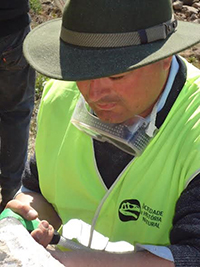 Bruno C. Silva. Laboratório de Paleontologia e Paleoecologia, Sociedade de História Natural, Polígono Industrial do Alto do Ameal, Pav.H02 e H06, 2565-641, Torres Vedras, Portugal. bcsilva.paleo@gmail.com
Bruno C. Silva. Laboratório de Paleontologia e Paleoecologia, Sociedade de História Natural, Polígono Industrial do Alto do Ameal, Pav.H02 e H06, 2565-641, Torres Vedras, Portugal. bcsilva.paleo@gmail.com
Bruno Camilo Silva has a vast experience in heritage management, having started his first palaeontological excavations of fossil vertebrates in 1995. Since then, he has promoted several works of intervention and salvage in palaeontological sites of the Portuguese Upper Jurassic western coast in general and in the Municipality of Torres Vedras, in particular. He is currently director of the Paleontology and Paleoecology Laboratory of the Natural History Society (Torres Vedras, Portugal), where he is responsible for the collections. In the scope of this collections he co-coordinates the Geographic Information System Applied to Paleontology, developed by the Geographic Information Department of the Natural History Society. His main interests are the management of palaeontological heritage and the palaeobiology of archosaurs of the Upper Jurassic.

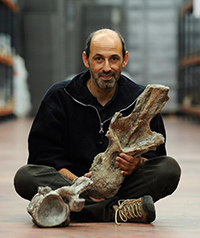 Francisco Ortega. Grupo de Biología Evolutiva, Facultad de Ciencias, UNED, c/ Senda del Rey, 9, 28040 Madrid, Spain; Laboratório de Paleontologia e Paleoecologia, Sociedade de História Natural, Polígono Industrial do Alto do Ameal, Pav.H02 e H06, 2565-641, Torres Vedras, Portugal. fortega@ccia.uned.es
Francisco Ortega. Grupo de Biología Evolutiva, Facultad de Ciencias, UNED, c/ Senda del Rey, 9, 28040 Madrid, Spain; Laboratório de Paleontologia e Paleoecologia, Sociedade de História Natural, Polígono Industrial do Alto do Ameal, Pav.H02 e H06, 2565-641, Torres Vedras, Portugal. fortega@ccia.uned.es
PhD in Biology (Paleontology) and Professor at the Faculty of Sciences of UNED (Madrid) in which he teaches in subjects related to biodiversity to student of Environmental Sciences. He is also the IP of the Evolutionary Biology Research Group-UNED, focusing his work on the analysis of the evolutionary history of Mesozoic reptiles, especially crocodiles and dinosaurs, and the ecosystems in which they inhabited. He is the author of more than a hundred publications in scientific and technical journals that mainly focused in the Late Jurassic of the Lusitanian Basin (Portugal), and the Cretaceous from the Spain (Las Hoyas, Lo Hueco and Morella fossil sites among others). In the field of paleontological heritage management has been a curator of the collections of paleontology of the Museum of Sciences of Castilla-La Mancha in Cuenca. He has also been involved in the generation of museum and museographic projects in Spain and Portugal. He has participated in different research paleontological projects in Spain, Portugal, Niger, Argentina and the United States, which implies being part of almost one hundred excavations and some dozens of national and international research projects. more: http://www.biouned.com/personal/fortega/
FIGURE 1. Geological map (adapted from Oliveira et al., 1992) showing the Portuguese Mesozoic levels outcropping in the Lusitanian Basin. ASb - Arruda Sub-basin; BSb - Bombarral Sub-basin, cd - Caldas Diapir; CR - Caldas da Rainha town; TSb - Turcifal Sub-basin.

FIGURE 2. Lusitanian Basin (divided into three sectors following Ribeiro et al., 1996) with the location of the Upper Jurassic sub-basins following two different interpretations: (1) location of Bombarral, Turcifal and Arruda Sub-basins (Guery, 1984; Kullberg, 2000; Kullberg et al., 2006) (modified from Kullberg, 2000); (2) location of Bombarral-Alcobaça, Consolação, Arruda and Turcufal Sub-basin (modified from Taylor et al., 2014).

FIGURE 3. Stratigraphic correlation between the nomenclature proposed for the Upper Jurassic sub-basin of the central sector of the Lusitaninan Basin [Bombarral Sub-basin is split in several areas: Consolação Sub-basin areas (Torres Vedras-Lourinhã-Peniche and Foz do Arelho-Nazaré coastal sector), Bombarral-Alcobaça Sub-basin area, Batalha-Leiria region and Pombal region], from the left to the right: i) Arruda Sub-basin (Kullberg et al., 2006); ii) Turcifal Sub-basin (Pereda-Suberbiola et al.,2005; Kullberg et al., 2006; Schneider et al., 2009); ii) Arruda Sub-basin (Kullberg et al., 2006); iii) Torres Vedras-Lourinhã-Peniche (Manuppella et al., 1999), iv) Foz do Arelho-Nazaré coastal sector (Kullberg et al., 2006; Azerêdo et al., 2010); v) Bombarral-Alcobaça Sub-basin area (Kullberg et al., 2006; Azerêdo et al., 2010); vi) Batalha-Leiria region (Manuppella et al., 2000; Kullberg et al. 2006; Escaso et al., 2007a) and vii) Pombal region (Kullberg et al., 2006; Malafaia et al., 2010a). The stratigraphy proposed by Hill (1988) for the coastal sector from Porto da Calada to Salir do Porto is also plotted. Crn - Chronostratigraphy; **sensu Yagüe et al., 2006. The right column shows the known stratigraphic distribution of the main sauropod clades along the Kimmeridgian-Tithonian sedimentary sequence in the Lusitanian Basin. The black bar indicates the known stratigraphic distribution of the established sauropod taxa (1, Zby atlanticus ; 2, Dinheirosaurus lourinhanensis ; 3, Lourinhasaurus alenquerensis ; 4, Lusotitan atalaiensis); CSb, Consolação Sub-Basin (following Taylor et al., 2014).

FIGURE 4.1, Simplified stratigraphy of the Kimmeridgian-Tithonian sequence in the Pombal, Leiria, and Batalha areas (located on the Bombarral Sub-basin) (Manuppella et al., 2000; Kullberg et al., 2006; Escaso et al., 2007a; Malafaia et al., 2010a) with distribution of the main sauropod clades identified in this area. 2-3, Geological map of Pombal (2) and Leiria and Batalha (3) areas with localities yielding fossil remains referred to Sauropoda (modified from Teixeira et al., 1966; Zbyszewski et al., 1974; Zbyszewski and Ferreira, 1978; Manuppella et al., 2000). Crn - Chronostratigraphy. *the presence of Turiasauria is only supported by the presence of heart-shaped teeth.

FIGURE 5. Cranial and postcranial sauropod remains from Pombal, Leiria, and Batalha areas: 1, Macronaria indet., compressed cone-chisel-shaped tooth (MG 8779, Ourém) in labial view; 2-3, Macronarian indet., compressed cone-chisel-shaped tooth (MG 27891, Guimarota) in labial (2) and lingual (3) views; 4, Sauropoda indet., middle or posterior caudal vertebra (MG 4811, Albergaria dos Doze) in right view; 5, Diplodocoidea indet., pencil-shaped teeth (MNHNUL.P.AND303, Andrés) in labial view; 6-7, ?Turiasauria indet., heart-shaped tooth (MG 16, Ourém) in lingual (6) and labial (7) views; 8-9, Eusauropoda indet., posterior or middle dorsal neural spine (MNHN.unnumbered, Vermoil) in posterior (8) and anterior (9) views; 10-13, Sauropoda indet., anterior, and middle caudal vertebra from a partial caudal series (MG 4974, Abadia) in posterior (10, 12) and right (11, 13) views; 14, sauropod fossil-site in Junqueira locality (Pombal); 15-18, sauropod material from near Batalha (MG 30389) that might represent an indeterminate diplodocine, middle caudal vertebra in ventral (15) and right (16) views, partial posterior (?) dorsal centrum in right view (17), and partial ischiatic peduncle in lateral view (18). Black scale bar: 10 cm; Gray scale bar: 0.5cm. See Anatomical abbreviations for abbreviations.

FIGURE 6. 1, Geological map of the coastal sector from Foz do Arelho to Nazaré area (located on the Bombarral Sub-basin, and considered part of the Consolação Sub-basin following Taylor et al., 2014) (modified from Zbyszewski and Moitinho de Almeida, 1960; Camarate França and Zbyszewski, 1963; Azerêdo et al., 2010) with the localities yielding fossil remains referred to Sauropoda. 2, Simplified stratigraphy of the Kimmeridgian-Tithonian sequence for the coastal sector from Foz do Arelho to Nazaré sector based on Azerêdo et al. (2010) with the stratigraphic distribution of the main sauropod clades identified in this area. Crn - Chronostratigraphy; *the presence of Turiasauria is only supported by the presence of heart-shaped teeth.
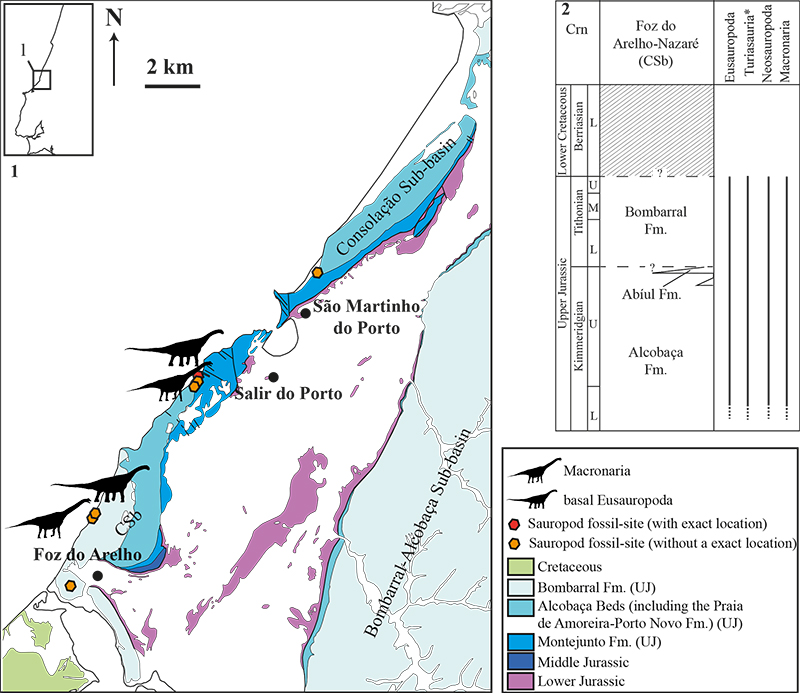
FIGURE 7. Cranial and postcranial sauropod remains from the coastal sector from Foz do Arelho to Nazaré: 1-3, Eusauropod material (MMPM.P/551) found near the São Martinho do Porto locality, middle caudal vertebra in anterior (1) and right (2) views and a partial anterior or middle chevron in posterior view (3); 4-5, ?Turiasauria indet., heart-shaped tooth (MG 4832, São Martinho do Porto) in lingual (4) and labial (5) views; 6-7, ?Turiasauria indet., heart-shaped tooth (SHN 501, Praia da Gralha) in labial (6) and lingual (7) views; 8, Eusauropoda indet., anterior dorsal neural spine (MG 4920, Foz do Arelho) in anterior view; 9-10, ? Macronaria indet., spatulate tooth (SHN 517, Foz do Arelho) in lingual (9) and labial (10) views; 11-13, ?Turiasauria indet., heart-shaped tooth (SHN 508, Serra do Bouro) in lingual (11), labial (12) and distal (13) views; 14-15, ?Turiasauria indet., heart-shaped tooth (SHN 512, Foz do Arelho) in lingual (14) and labial (15) views; 16-17, ?Turiasauria indet., heart-shaped tooth (SHN (JJS) 146, Salir do Porto) in lingual (16) and labial (17) views; 18, Sauropoda indet., middle caudal vertebra (SHN 537, Salir do Porto) in left view. Black scale bar: 5 cm; Grey scale bar: 0.5 cm. See Anatomical abbreviations for abbreviations.

FIGURE 8. 1, Geological map of the Alcobaça, Bombarral and A-dos-Cunhados region (located on the Bombarral Sub-basin, and considered part of the Bombarral-Alcobaça Sub-basin following Taylor et al., 2014) (modified from Camarate França et al., 1960; Zbyszewski and Moitinho de Almeida, 1960; Camarate França and Zbyszewski, 1963; Zbyszewski and Torre de Assunção, 1965; Zbyszewski et al., 1966; Azerêdo et al., 2010) with the localities yielding fossil remains referred to Sauropoda. 2, Simplified stratigraphy of the Kimmeridgian-Tithonian sequence for Bombarral-Alcobaça Sub-basin (stratigraphy based on Kullberg et al., 2006 and Azerêdo et al., 2010) with the stratigraphic distribution of the main sauropod clades identified in this area. Crn - Chronostratigraphy. *the presence of Turiasauria is only supported by the presence of heart-shaped teeth.
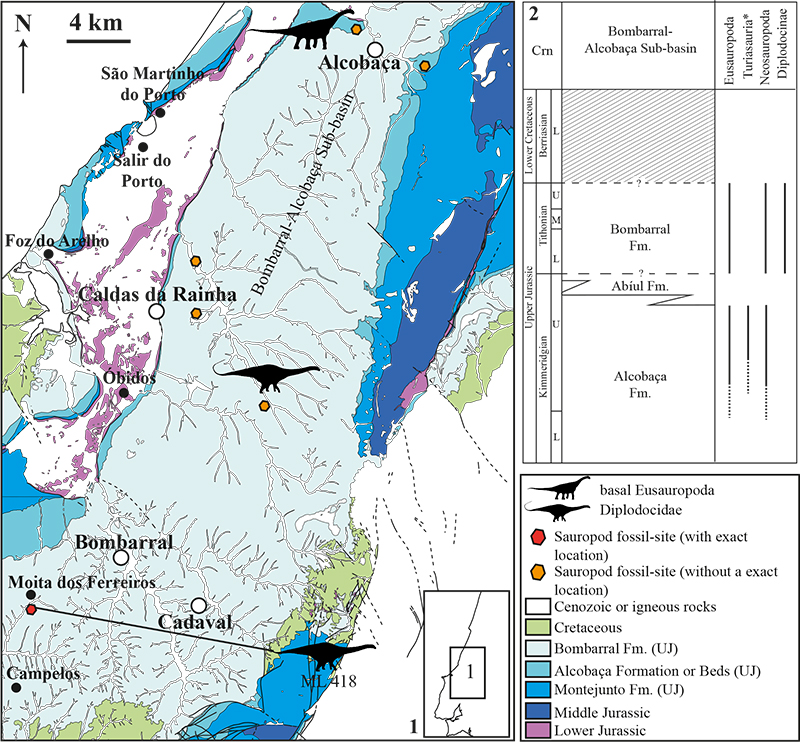
FIGURE 9. Cranial and postcranial sauropod remains from the Alcobaça, Bombarral and A-dos-Cunhados region: 1-2, Eusauropoda indet., left astragalus (MMPM.P/75, Imaginário) in proximal (1) and posterior (2 views; 3-4, Diplodocinae indet., middle caudal vertebra (MG 4819, São Gregório da Fanadia) in right (3) and ventral (4) views; 5, Sauropoda indet., anterior caudal vertebra (MG 4804, Salir de Matos) in right view; 6-7, ?Turiasauria indet., heart-shaped tooth (MG 277, Fervença) in labial (6) and lingual (7) views; 8, Diplodocinae indet., middle or posterior dorsal vertebra (ML 418, Moita dos Ferreiros) in posterior view. Black scale bar: 10 cm; Grey scale bar: 0.5cm. See Anatomical abbreviations for abbreviations.
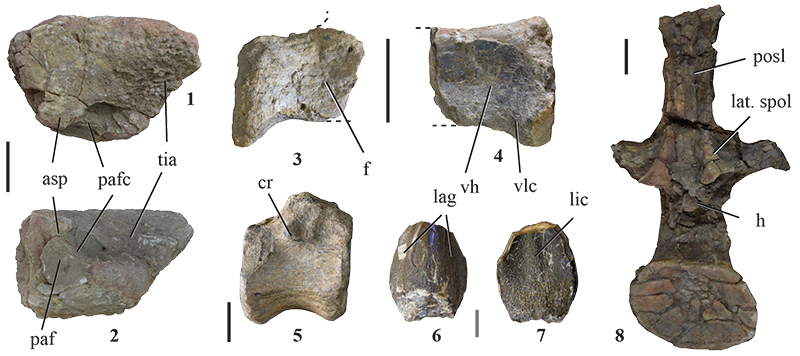
FIGURE 10. 1, Geological map of the Peniche area (located on the Bombarral Sub-basin, and considered part of the Consolação Sub-basin following Taylor et al., 2014) (modified from Camarate França et al., 1960; Zbyszewski and Moitinho de Almeida, 1960; Azerêdo et al., 2010) with the localities yielding fossil remains referred to Sauropoda. 2, Simplified stratigraphy of the Kimmeridgian-Tithonian sequence for the Peniche area based on Manuppella et al. (1999, first column) and Hill (1988, second column) with the stratigraphic distribution of the main sauropod clades identified in this area. 3) Sediments of the Bombarral Formation in the Almagreira Cliffs. Crn - Chronostratigraphy; *the presence of Turiasauria is only supported by the presence of heart-shaped teeth.
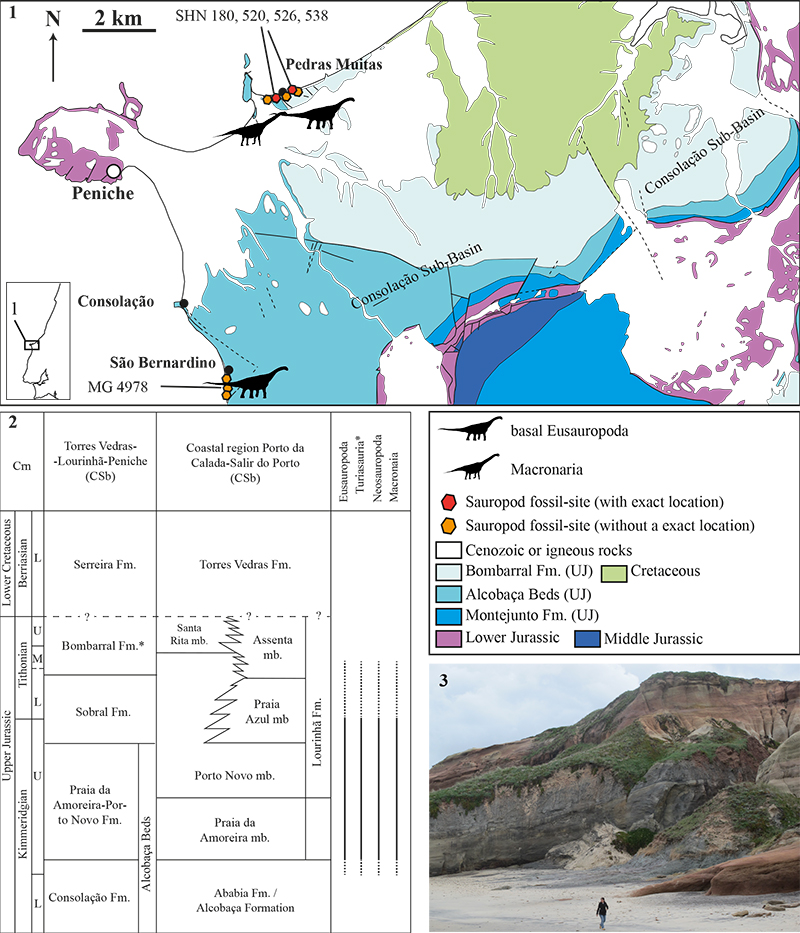
FIGURE 11. Cranial and postcranial sauropod remains from the cliffs located on North of Peniche: 1, ?Macronaria indet., partial spatulate tooth (MG 8783, Baleal) in lingual view; 2-3, ?Turiasauria indet., heart-shaped tooth (SHN (JJS) 141, Baleal) in labial (2) and lingual (3) views; 4, Macronaria indet., compressed cone-chisel-shaped tooth (SHN 547, Pedras Muitas) in lingual view; 5-6, Eusauropoda indet., middle (MG 4917) and posterior cervical vertebrae from Pedras Muitas in right (5) and left (6) views, respectively; 7, Macronaria indet., compressed cone-chisel-shaped tooth (SHN 543, Baleal) in lingual view; 8, sacral rib (SHN, 538, Almagreira) in posterior or anterior view; 9, Eusauropoda indet., anterior caudal vertebra (SHN 180, Baleal) in left view; 10, Macronaria indet., right pubis (SHN 526, Almagreira) in lateral view. Black scale bar: 10 cm; Grey scale bar: 1 cm. See Anatomical abbreviations for abbreviations.
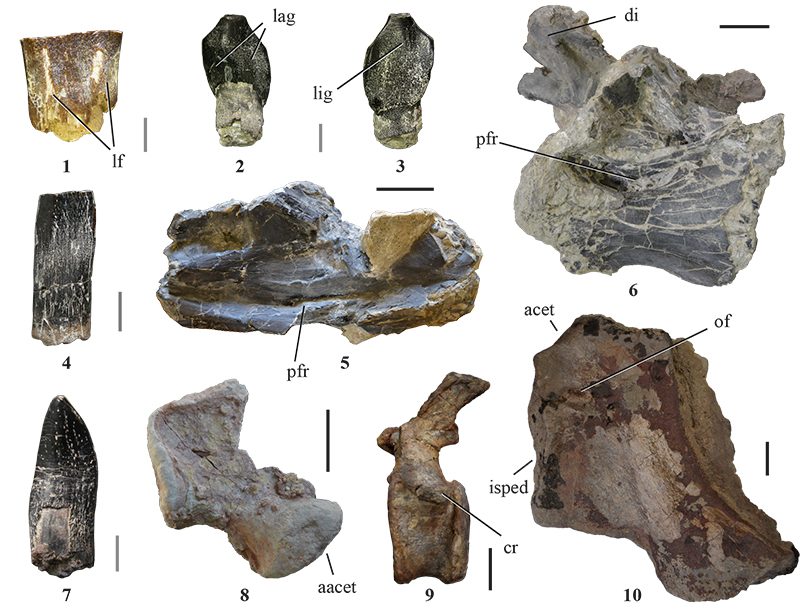
FIGURE 12. 1, Geological map of the coastal sector of Praia da Consolação-Lourinhã-Torres Vedras (located on the Bombarral Sub-basin, and considered part of the Consolação Sub-basin following Taylor et al., 2014) (modified from Manuppella et al., 1999) with the localities yielding fossil remains referred to Sauropoda. 2, Simplified stratigraphy of the Kimmeridgian-Tithonian sequence for the coastal sector of Praia da Consolação-Lourinhã-Torres Vedras based on Manuppella et al. (1999, first column) and Hill (1988, second column) with the stratigraphic distribution of the main sauropod clades identified in this area. Crn - Chronostratigraphy. *the presence of Turiasauria is only supported by the presence of heart-shaped teeth and the holotype of Zby atlanticus.
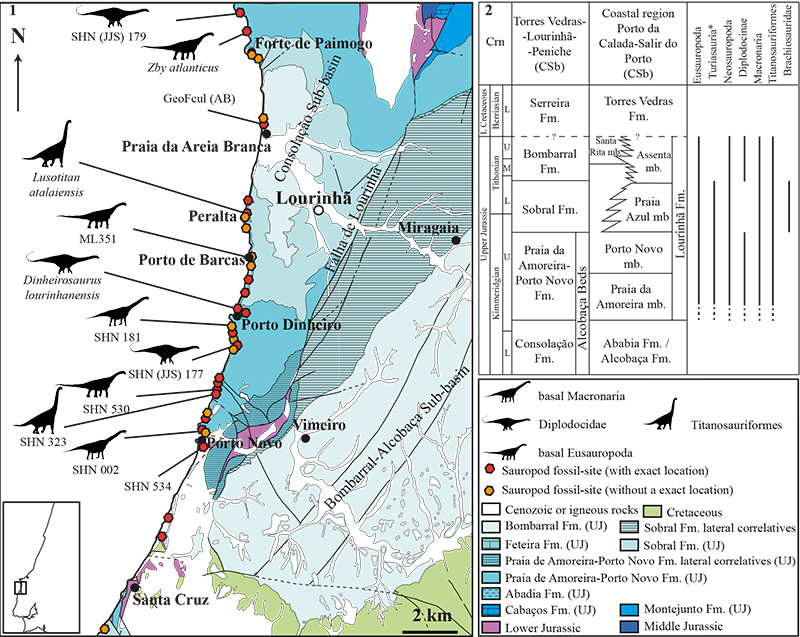
FIGURE 13. Cranial and postcranial sauropod remains from sediments of the Praia da Amoreira-Porto Novo Fm. of the coastal sector of Praia da Consolação-Lourinhã-Torres Vedras: 1-2, ?Turiasauria indet., heart-shaped tooth (SHN (JJS) 142, Praia da Corva) in lingual (1) and labial (2) views; 3-4, ?Macronaria indet., spatulate tooth (SHN 513, Porto Novo) in labial (3) and lingual (4) views; 5-6, Macronaria indet., compressed cone-chisel-shaped tooth (SHN 578, Valmitão) in lingual (5) and labial (6) views; 7-8, Eusauropoda indet., partial left maxilla (SHN 582, Praia dos Frades) in lateral (7) and posterior (8) views; 9, Titanosauriformes indet., posterior caudal vertebra (SHN 523, Praia da Corva) in right view; 10-12, Diplodocinae indet., partial skeleton (SHN (JJS) 177, Valmitão), anterior caudal neural spine in posterior view (10), anterior caudal centrum in right view (11) and left ischium in medial view (12); 13-16, holotype material of Zby atlanticus (ML 368, Vale de Pombas), right ungueal I in lateral view (13), right humerus in anterior view (14), right radius in posterior view (15), right ulna in lateral view (16); 17, Eusauropoda indet., partial distal forked-chevron (SHN 587, Praia da Corva) in medial view; 18, Sauropoda indet., pedal ungueal I (SHN 524, Praia de Pedrogãos) in lateral view; 19-22, Macronarian indet., partial skeleton (SHN 181, Valmitão), right astragalus in proximal view (19), anterior caudal vertebra in anterior view (20), right tibia in lateral view (21) and right fibula in medial view (22); 23-24, Eusauropoda indet., partial skeleton (SHN 530, Praia da Corva), anterior chevron in anterior view (23) and anterior caudal vertebra in posterior view (24); 25, cf. Duriatitan humerocristatus, humerus (MG 4976, Praia dos Frades) in anterior view; 26, Sauropoda indet., partial skeleton (SHN 534, Santa Rita), middle chevron in posterior view; 27, Diplodocidae indet., partial skeleton (SHN (JJS) 179, Praia Vermelha), dorsal/caudal (?) neural spine in posterior view; 28-30, holotype material of Dinheirosaurus lourinhanensis (ML 414, Porto Dinheiro), proximal end of a dorsal rib in anterior view (28), anterior caudal neural spine in posterior view (29) and articulated dorsal vertebrae in right view (30). Black scale bar: 10 cm; Grey scale bar: 5 cm; Brown scale bar: 1 cm. See Anatomical abbreviations for abbreviations.
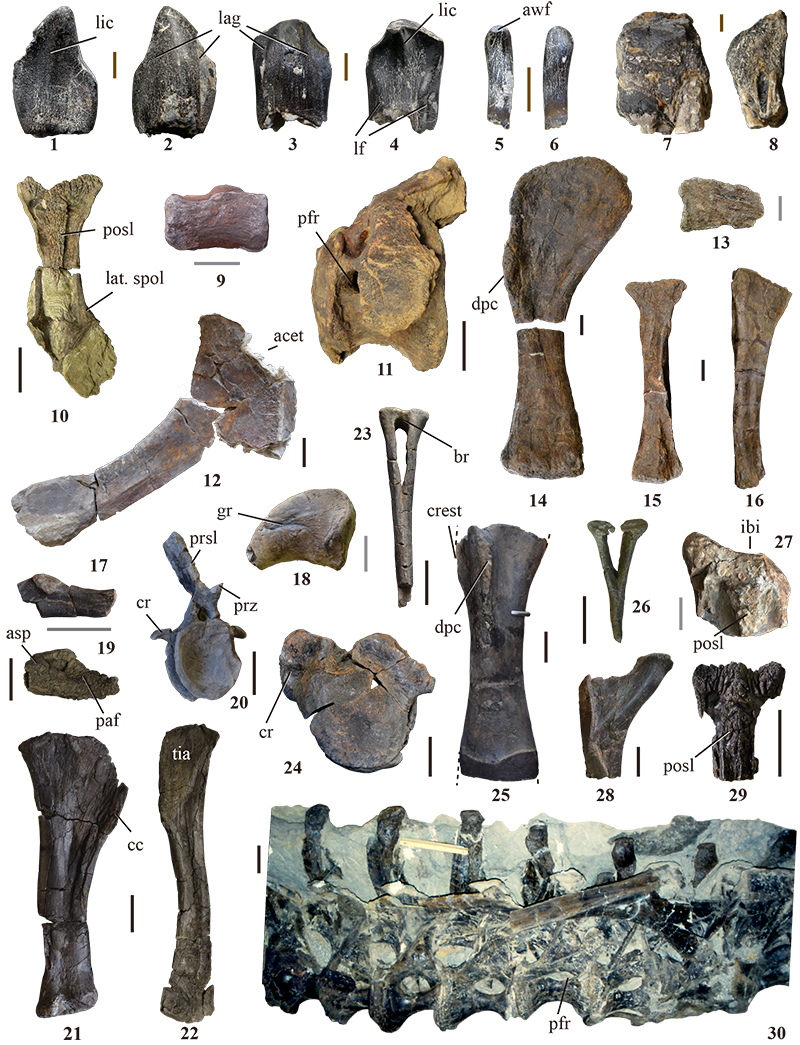
FIGURE 14. 1,Dinheirosaurus lourinhanensis dorsal series (ML 414) in Porto Dinheiro with the palaeontologist Pedro Dantas in 1991. 2-3, A partial skeleton in the field (SHN 534) collected in Santa Rita, including a partial tail, in 2003 (2) and several appendicular bones, in 2009 (3).
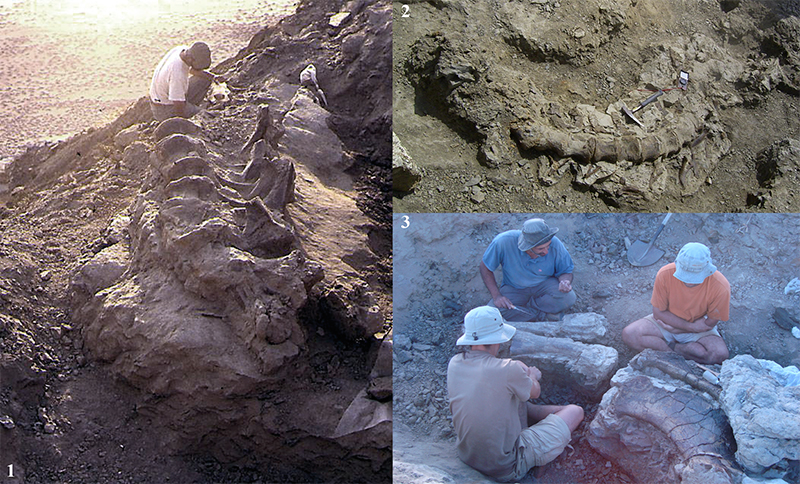
FIGURE 15. Cranial and postcranial sauropod remains from sediments of the Sobral Fm. and Bombarral Fm. of the coastal sector of Praia da Consolação-Lourinhã-Torres Vedras: 1-2, ?Macronaria indet., spatulate tooth (SHN 122, Peralta) in labial (1) and lingual (2) views; 3-6, Macronaria indet., compressed cone-chisel-shaped teeth (SHN 550 and 551, Peralta) in labial (3, 5) and lingual (4, 6) views; 7, Sauropoda indet., left dorsal transverse process (MG 8809, Atalaia) in dorsal view; 8, Eusauropoda indet., anterior caudal vertebra (MNHNUL.P.R27) in posterior view (Praia da Areia Branca); 9-14, lectotype material of Lusotitan atalaiensis (Peralta), anterior caudal vertebra MG 4985-2 (11) and MG 4985-4 (9) in posterior view, left astragalus (MG 4803) in posterior view (10), right humerus (MG 4989) in anterior view (12), right radius (MG 4958) in anterior view (13), right tibia (MG 4981) in posterior view (14); 15, Titanosauriformes indet., a proximal end of left femur (MG 4986, Praia da Areia Branca) in anterior view; 16-19, Eusauropoda indet., partial tail (GeoFCUL(AB), Areia Branca), middle chevron in posterior view (16), middle caudal vertebra GeoFCUL(AB) 22 in anterior view (17), GeoFCUL(AB) 21 in left view (18), GeoFCUL(AB) 20 in posterior view (19). Black scale bar: 10 cm; Grey scale bar: 1 cm. See Anatomical abbreviations for abbreviations.
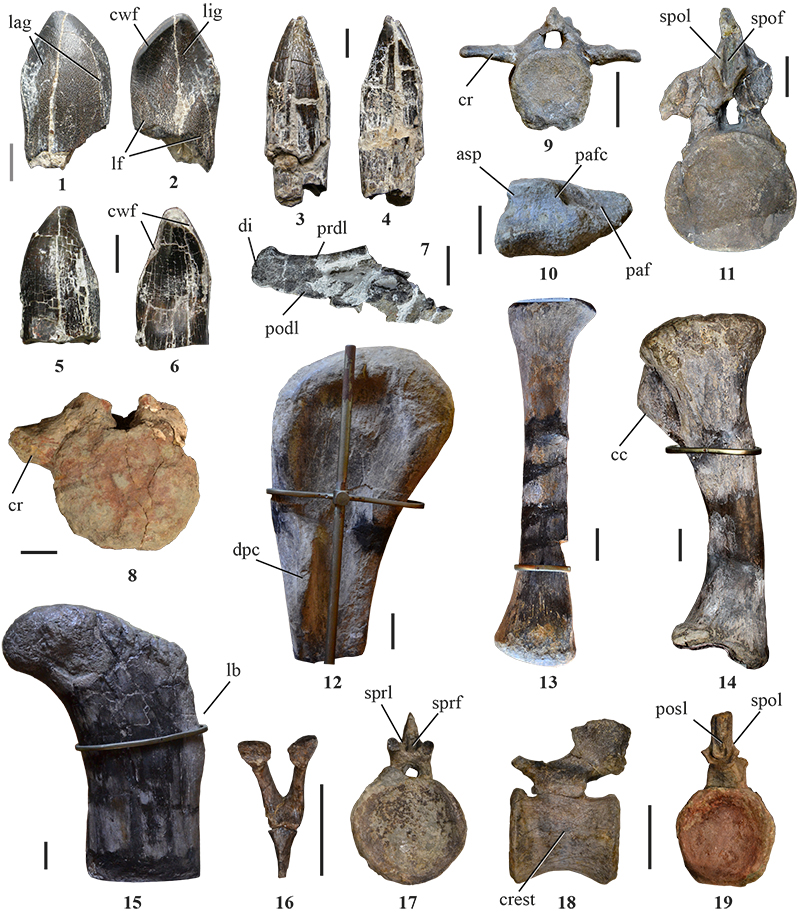
FIGURE 16. 1, Geological map of Arruda Sub-basin (modified Zbyszewski and Torre de Assunção, 1965; Zbyszewski et al., 1966) with the localities yielding fossil remains referred to Sauropoda. 2, Simplified stratigraphy of the Kimmeridgian-Tithonian sequence for Arruda Sub-basin based on Kullberg et al. (2006) with the stratigraphic distribution of the main sauropod clades identified in this area. Crn - Chronostratigraphy.
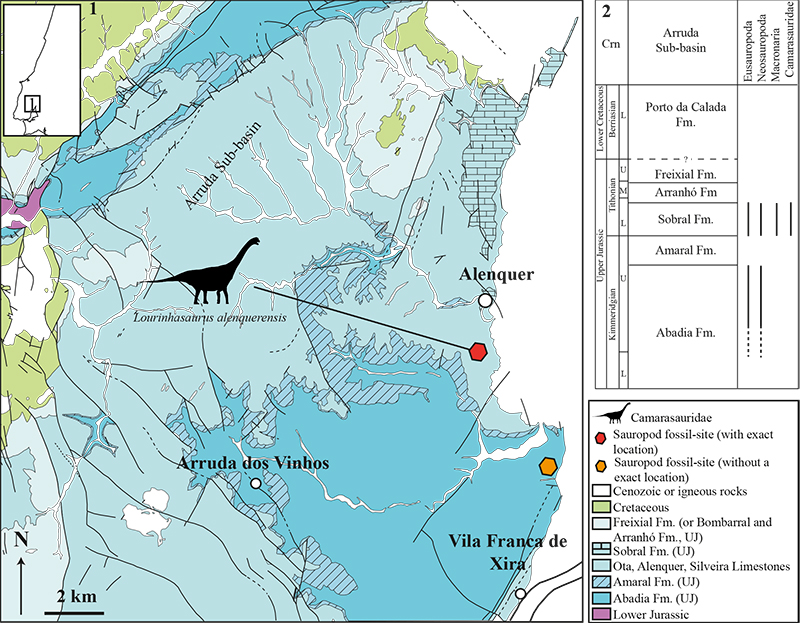
FIGURE 17. Postcranial sauropod remains from the Arruda Sub-basin: 1-6 and 8-17, lectotype material of Lourinhasaurus alenquerensis (Moinho do Carmo), middle-to-posterior cervical centrum (MG 30373) in left view (1), fused sacral neural spines (MG 30376) in left view (2), dorsal centrum (MG 4956) in left view (3), anterior caudal neural spine (MG 30374) in posterior (4) and anterior (5) views, anterior caudal centrum (MG 4956) in anterior view (6), middle dorsal neural spine (MG 30384) in posterior view (8), left ischium (MG 4957) in lateral view (9), posterior cervical neural spine (MG 30379) in right view (10), left scapula and coracoids (MG 5780) in lateral view (11), left astragalus (MG 30375) in proximal view (12), left pubis (MG 4970) in lateral view (13), left tibia (MG 4983) in anterior view (14), left fibula (MG 4984) in lateral view (15), left humerus (MG 2) in anterior view (16) and left femur (MG 4931) in posterior view (17); 7, Neosauropoda indet., partial dorsal centrum (MG 4799, Castanheira) in right view. Black scale bar: 10 cm. See Anatomical abbreviations for abbreviations.
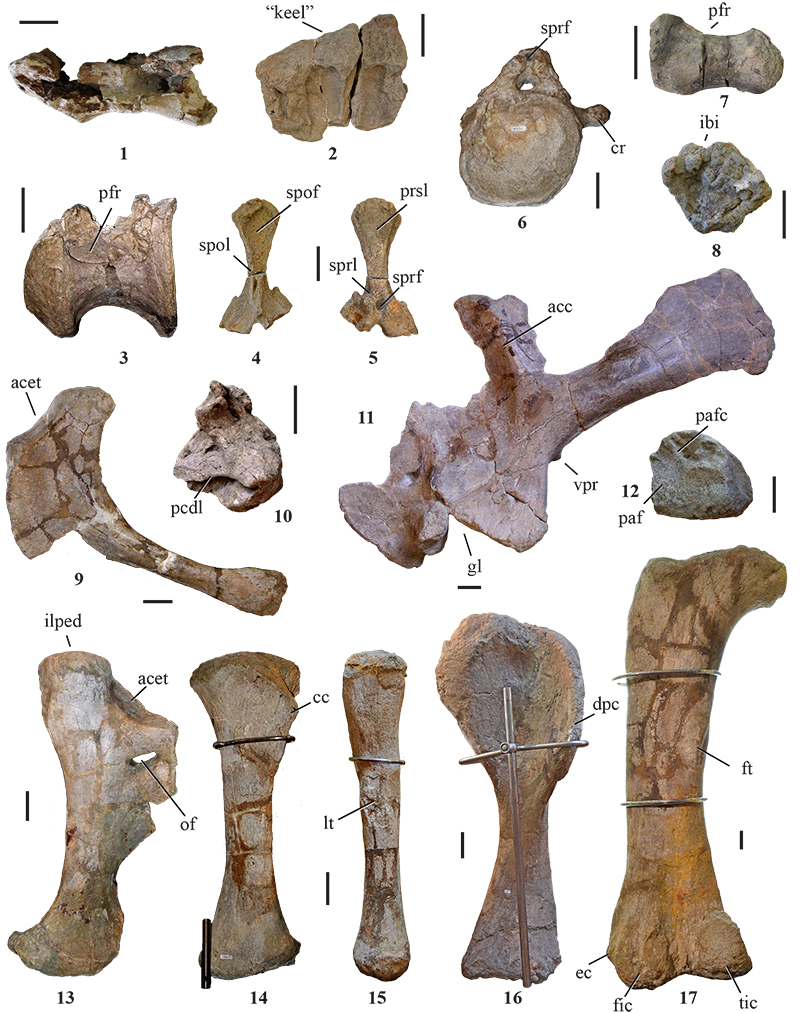
FIGURE 18. 1, Simplified stratigraphy of the Kimmeridgian-Tithonian sequence for Turcifal Sub-basin based on Pereda-Suberbiola et al. (2005), Kullberg et al. (2006) and Schneider et al. (2009) with the stratigraphic distribution of the main sauropod clades identified in this area. 2, Geological map of Turcifal Sub-basin (modified from Zbyszewski et al., 1955) with the localities yielding fossil remains referred to Sauropoda. Crn - Chronostratigraphy; *the presence of Turiasauria is only supported by the presence of heart-shaped teeth.
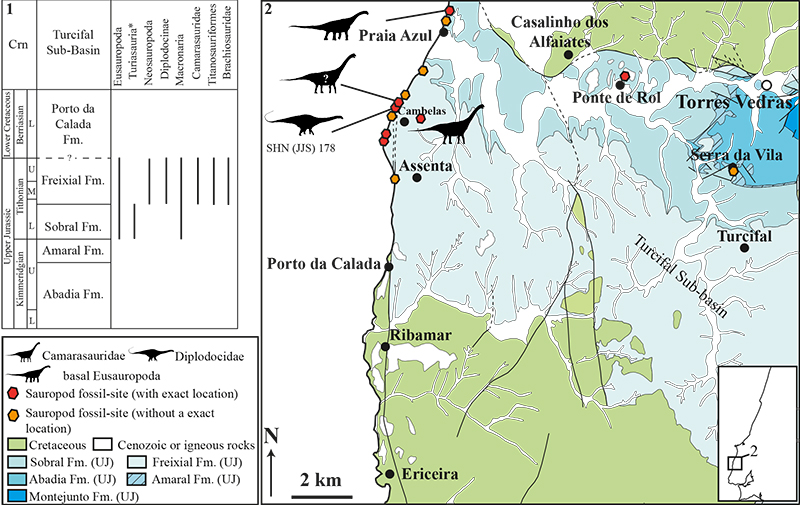
FIGURE 19. Cranial and postcranial sauropod remains from the Turcifal Sub-basin: 1-2, ?Turiasauria, heart-shaped tooth (SHN (JJS) 140, Cambelas) in labial (1) and lingual (2) views; 3-4, Macronaria indet., compressed cone-chisel-shaped tooth (SHN 580, Assenta) in lingual (3) and labial (4) views; 5, ?Macronaria indet., spatulate tooth (SHN 519, South of Foz do Sizandro) in lingual view; 6, Eusauropoda indet., middle cervical vertebra (SHN 528, Porto Barril) with camellae tissue bone (sensu Wedel, 2003); 7-8, ?Camarasauridae indet., anterior caudal neural spine (SHN 529, Cambelas) in left (7) and anterior (8) views; 9, Sauropoda indet., right tibia (SHN 527, Cambelas) in proximal view; 10, Sauropoda indet., middle caudal vertebra (MG 4802, Santa Cruz) in right view; 11-12, partial distal end of a ?left tibia (MG 8803, Serra da Vila) in anterior (11) and distal (12) views; 13, humerus distal end (SHN 584, Assenta) in anterior view; 14, cf. Lusotitan atalaiensis, middle caudal vertebra (MG 8804, Maceira) in right view; 15-16, Sauropoda indet., partial skeleton (SHN, 532, Ponte de Rol), posterior caudal vertebra in left view (15) and distal end of a right femur in anterior (16) views; 17-19, Diplodocidae indet., partial skeleton (SHN (JJS) 178, Cambelas), sacral neural spines in anterior (17) and left (18) views and right femur in anterior (19) view. Black scale bar: 10 cm; Grey scale bar: 1 cm. See Anatomical abbreviations for abbreviations.
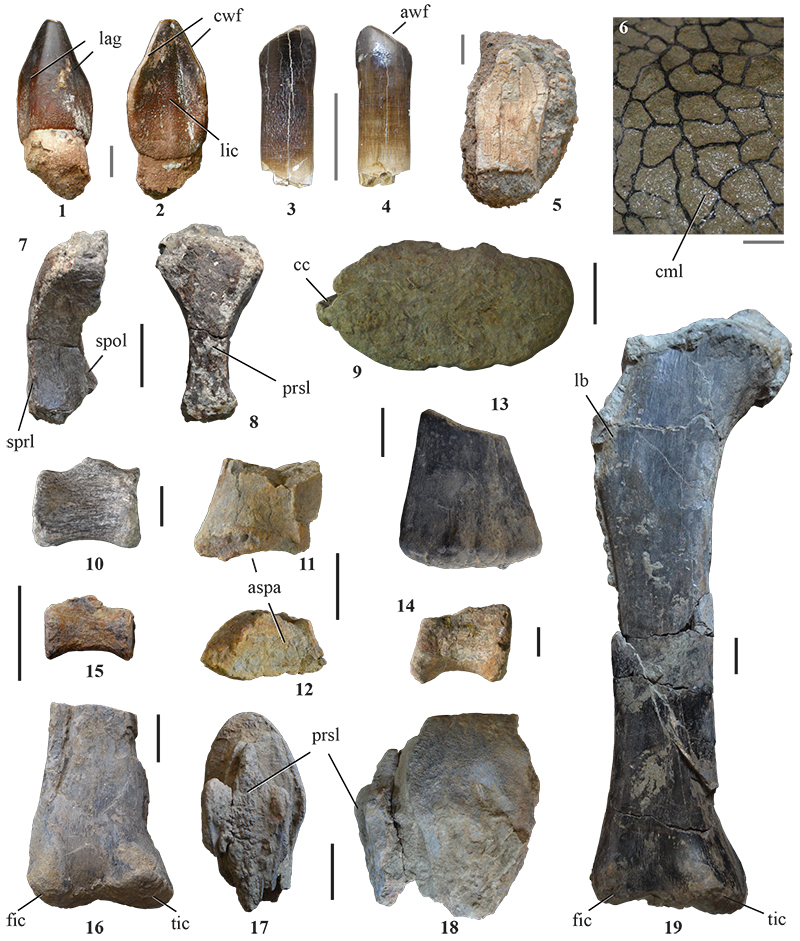
FIGURE 20. Dorsal vertebrae in the field of a partial skeleton (SHN 531) collected in Casal da Costa (Cambelas) in 2003, and correspond to a member of Camarasauridae clade.
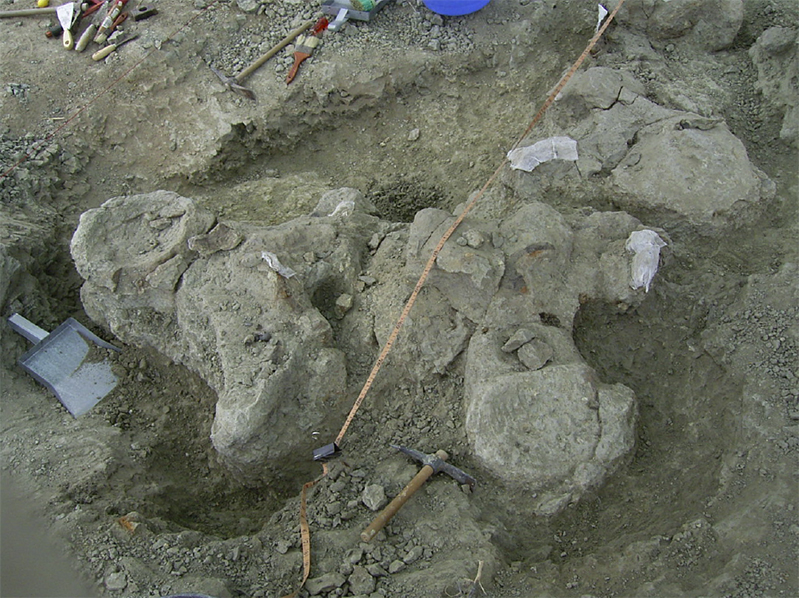
Upper Jurassic sauropod record in the Lusitanian Basin (Portugal): geographical and lithostratigraphical distribution
Plain Language Abstract
Sauropod dinosaurs were abundant in the Portuguese Late Jurassic. Fossil remains from this group of dinosaurs are present along the continental Upper Jurassic sequence deposited in the Lusitanian Basin. Several new sauropod specimens are reported in this study, which provide important information about the evolutionary history of Late Jurassic sauropods in the Iberian territory. The Portuguese Late Jurassic sauropods are represented by non-neosauropod eusauropods (including turiasaurs), diplodocids (including diplodocines), basal macronarians, and titanosauriforms (some specimens with brachiosaurid affinities).
Resumen en Español
Registro de saurópodos del Jurásico Superior en la Cuenca Lusitaniana (Portugal): distribución geográfica y litoestratigráfica
Los restos de saurópodos son relativamente abundantes en los sedimentos del Jurásico Superior de la Cuenca Lusitaniana. Estos dinosaurios se registran en varias subcuencas formadas durante el tercer episodio de rifting relacionado con la evolución de la Cuenca Lusitaniana. La secuencia sedimentaria kimmeridgiana-tithoniana se encuentra dominada por depósitos silicoclásticos indicadores de un ambiente continental. Los saurópodos están presentes todo a lo largo de esta secuencia principalmente terrestre y se registran en las formaciones Alcobaça, Praia da Amoreira-Porto Novo, Sobral, Freixial, y Bombarral, en el intervalo kimmeridgiano temprano a tithoniano tardío. Sauropoda es el grupo de dinosaurios más abundante en el Jurásico Superior de la Cuenca Lusitaniana y se halla particularmente bien representado en las subcuencas Bombarral y Turcifal. Aquí se presentan varios especímenes nuevos que no habían sido publicados. La fauna de saurópodos identificada incluye, principalmente, eusaurópodos no neosaurópodos (incluyendo turiasaurios), diplodocoideos (algunos especímenes con afinidades diplodocinas), macronarianos basales (camarasáuridos y no camarasáuridos) y titanosauriformes (algunos especímenes con afinidades braquiosáuridas). Macronarianos, turiasaurios y diplodocoideos se encuentran presentes generalmente a lo largo de todos los depósitos continentales a transicionales del kimmeridgiano-tithoniano de la Cuenca Lusitaniana, pero el registro fósil conocido para algunos grupos más exclusivos tales como camarasáuridos, braquiosáuridos y diplodocinos, presenta una distribución estratigráfica más restringida.
Palabras clave: Sauropoda, Jurásico Superior, Cuenca Lusitaniana, subcuenca Bombarral, subcuenca Arruda, subcuenca Turcifal.
Traducción: Diana Elizabeth Fernández
Résumé en Français
Le registre fossile des sauropodes dans le Jurassique supérieur du Bassin lusitanien (Portugal) : distribution géographique et lithostratigraphique
Les restes de sauropodes sont relativement abondants dans les sédiments du Jurassique supérieur du Bassin lusitanien. Ces dinosaures sont documentés dans plusieurs sous-bassins formés pendant le troisième épisode de rifting lié à l'évolution du Bassin lusitanien. La séquence sédimentaire du Kimméridgien-Tithonien est dominée par des dépôts silicoclastiques, indiquant un environnement continental. Les sauropodes sont présents tout le long de cette séquence principalement terrestre : ils sont documentés dans les formations d'Alcobaça, Praia da Amoreira-Porto Novo, Sobral, Freixial, et Bombarral, du Kimméridgien ancien au Tithonien récent. Les Sauropoda sont les dinosaures les plus abondants dans le registre fossile du Jurassique supérieur du Bassin lusitanien et ils sont particulièrement bien représentés dans les sous-bassins de Bombarral et Turcifal. Plusieurs nouveaux spécimens non publiés sont présentés ici. La faune de sauropodes identifiée comprend principalement des eusauropodes non néosauropodes (incluant les turiasaures), des diplodocoïdes (certains spécimens présentant des affinités avec les diplodocinés), des macronariens basaux (non camarasauridés et camarasauridés), et des titanosauriformes (certains spécimens présentant des affinités avec les brachiosauridés). Les macronariens, turiasaures, et diplodocoïdes sont généralement présents dans les dépôts continentaux à transitionnels du Bassin lusitanien tout le long du Kimméridgien-Tithonien, mais le registre fossile connu pour les camarasauridés, brachiosauridés, et diplodocinés indique une distribution stratigraphique plus restreinte.
Mots-clés : Sauropoda ; Jurassique supérieur ; Bassin lusitanien ; sous-bassin de Bombarral ; sous-bassin d'Arruda ; sous-bassin de Turcifal
Translator: Antoine Souron
Deutsche Zusammenfassung
Unterjurassischer Sauropodennachweis im Lusitanischen Becken (Portugal): geographische und lithostratigraphische Verteilung
Überreste von Sauropoden sind in den unterjurassischen Sedimenten des Lusitanischen Beckens relativ häufig. Diese Dinosaurier werden in verschiedenen Sub-Becken, die während des dritten Rifting-Prozesses im Zusammenhang mit der Entstehung des Lusitanischen Beckens entstanden sind, gefunden. Die Kimmeridge-Tithon Sedimentsequenz wird durch siliziklastische Ablagerungen dominiert, was auf einen kontinentalen Ablagerungsraum hinweist. Sauropoden kommen in der gesamten, hauptsächlich terrestrischen Sequenz vor. Sie werden in der Alcobaça, Praia da Amoreira-Porto Novo, Sobral, Freixial, und der Bombarral Formation verzeichnet und reichen damit vom frühen Kimmeridge bis in das späte Tithon. Sauropoda ist die häufigste Dinosauriegruppe im unterjurassischen Fossilnachweis des Lusitanischen Beckens und sie sind besonders gut erhalten im Bombarral und Turcifal Sub-Becken. Einige neue, bis jetzt unveröffentlichte Stücke werden hier aufgeführt. Die hauptsächlich identifizierte Sauropodenfauna beinhaltet nicht-neosauropode Eusauropoden (inklusive Turiasaurier), Diplodocoiden (einige Stücke mit Diplodocinen-Ähnlichkeiten), basale Macronaria (nicht-Camarasauride und Camarasauride) und Titanosauriforme (einige Stücke mit Brachiosauriden-Ähnlichkeiten). Macronaria, Turiasaurier und Diplodocoiden kommen generell entlang der gesamten kontinentalen bis transitionalen Ablagerungen des Lusitanischen Beckens vor (mit einem Alter vom Kimmeridge bis ins Tithon) aber der bekannte Fossilnachweis für noch etwas exklusivere Gruppen wie Camarasauriden, Brachiosauriden und Diplodocinen zeigt eine eingeschränktere stratigraphische Verteilung.
Schlüsselwörter: Sauropoda; Oberer Jura; Lusitanisches Becken; Bombarral Sub-Becken; Arruda Sub- Becken; Turcifal Sub- Becken
Translator: Eva Gebauer
Arabic
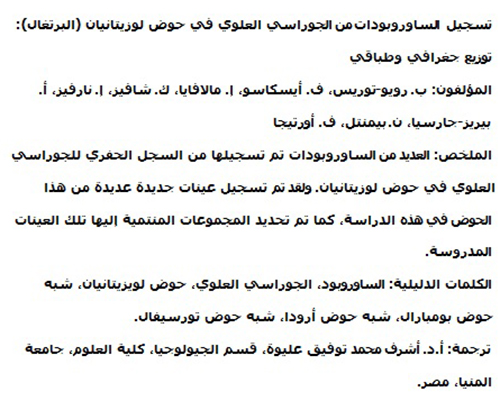
Translator: Ashraf M.T. Elewa
-
-
PE: An influential journal
 Palaeontologia Electronica among the most influential palaeontological journals
Palaeontologia Electronica among the most influential palaeontological journalsArticle number: 27.2.2E
July 2024





 A Review of Handbook of Paleoichthyology Volume 8a: Actinopterygii I, Palaeoniscimorpha, Stem Neopterygii, Chondrostei
A Review of Handbook of Paleoichthyology Volume 8a: Actinopterygii I, Palaeoniscimorpha, Stem Neopterygii, Chondrostei